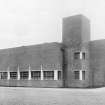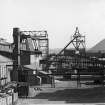Kelty Junction, Aitkin Colliery
Colliery (19th Century) - (20th Century), Railway Junction (19th Century) - (20th Century), Railway Station (19th Century) - (20th Century)
Site Name Kelty Junction, Aitkin Colliery
Classification Colliery (19th Century) - (20th Century), Railway Junction (19th Century) - (20th Century), Railway Station (19th Century) - (20th Century)
Alternative Name(s) Aitken Pit
Canmore ID 79305
Site Number NT19SE 33
NGR NT 1544 9479
Datum OSGB36 - NGR
Permalink http://canmore.org.uk/site/79305
- Council Fife
- Parish Beath
- Former Region Fife
- Former District Dunfermline
- Former County Fife
Field Visit (20 September 1991)
NT19SE 33 1544 9479
Opencast mining has removed Aitkin (or Aitken) Pit, and Kelty Station and Junction. The Aitkin Pit is first depicted on the OS 6-inch map in 1896, (Fifeshire, 1896, sheet xxxiv NE), and remained in use until 1963, the railway, closed in 1970, producing both house and steam coal. The mine had 2 shafts, one of 202 fathoms and the other, 95 fathoms deep. The mine was owned by the Fife Coal Company until nationalisation in 1947. (Cleish91 176)
Visited by RCAHMS (SPH) 20 September 1991.
Note (2006)
(Location cited as NT 1551 9481). AITKEN Colliery
Location: Kelty
Previous Owners: Fife Coal Company
Types of Coal: House, Steam and Navigation
Sinking/Production Commenced: 1895-9
Year Closed: 1963
Year Abandoned: 1969
Average Workforce: 1,249
Peak Workforce: 1,431
Peak Year: 1956
Shaft/Mine Details: 2 shafts, No. 1 (1896) 370m (NT 1551 9481), No. 2 (1923) 183m (NT 1555 9481) and sunk in 1923, linked to Lindsay Colliery [NT19SW 61].
Details in 1948: Average output 2,000 tons per day, 460,000 tons per annum. 1,368 employees. Baum-type washery (coal cleaning system using water and compressed air), National Coal Board (NCB) generated electricity at its own power station, the largest at any colliery in Scotland. Baths (1934, for 912 men, with 80 shower cubicles and steam-heated lockers), canteen, first-aid centre. Mechanisation of underground haulage already under way in 1947, introducing large mine cars, locomotive haulage and skip winding. Report dated 16-08-1948.
Other Details: Named after the Fife Coal Company's chairman, Thomas Aitken of Livingston. The first Fife Coal Company colliery, a showpiece pit, and at the time, said to be the largest coal mine in Scotland.
M K Oglethorpe 2006.
Aitken Colliery Baths, Fifeshire: (see SC 1073900) Opened: 25th August 1934. Accommodation: 912 men. Cost: £13,635. Architect: JA Dempster, Miners' Welfare Committee.
Miners' Welfare Committee, 1935.










